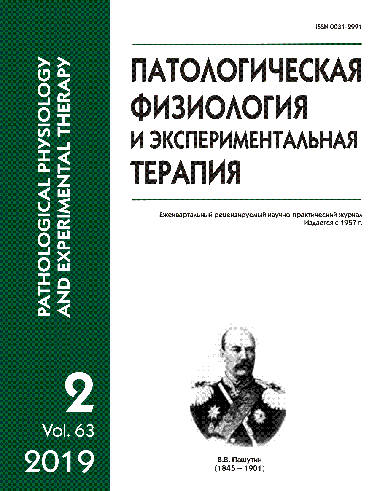A method for culturing of enteric nervous system cells suitable for tissue engineering of the intestine
Abstract
Background. Treatment of short bowel syndrome is a complex issue in modern medicine. Existing treatment methods are inefficient in some cases, and bowel transplantation shows unsatisfactory results. Tissue engineering of the small intestine can represent an innovative method of treatment for these patients. One of the key elements in creation of the gut is culturing of enteric nervous system cells. There is no description of the nerve cells culture extracted from the enteric nervous system and grown in a hyaluronic-acid based three-dimensional matrix so far. Research objective: establishing an in vitro method for culturing of interacting enteric nervous system cells in a 3D environment. Methods. The enteric nervous system cells used for these experiments were isolated from Sprague-Dawley rats. Hyaluronic-acid based hydrogel HyStem®-C (ESI BIO - A Division of BioTime, USA) was used as a 3D matrix. Enteric nervous system cells were isolated from 5- to 8-day-old newborn Sprague-Dawley rats. Animals were decapitated with a rodent guillotine (cervical spinal cord transection). After that they were laparotomized, and their intestines were isolated. The removed intestines were placed in a Petri dish filled with the MEM (Minimum Essential Medium) supplemented with antibiotics (25 µl factory-produced solution of gentamycin (40 mg/ml) and 50 µl of metronidazole solution (5 mg/ml) per 50 ml of MEM). The small intestine was then separated from the colon and mesentery under an optical microscope, and the muscular layer of small intestine was isolated from the submucosal layer. The isolated muscular layer was placed in a tube with the deoxyribonuclease and collagenase solution as well as Balanced Salt Solution and incubated for 2 h at 37°C and 5% CO₂. As a result, the intestinal muscle tissue was broken down completely in the produced solution, while areas of the myenteric plexus remained intact and were recognizable under the microscope as a network. These neural networks were treated with a trypsin solution. Further, after mechanical processing, a suspension of nerve cells was obtained. The hyaluronic-acid based gel HyStem®-C (ESI BIO - A Division of BioTime, Inc., USA) with added collagen was used to produce a 3D matrix. The enteric nervous system cells were added to this three-dimensional matrix and stirred. Matrix had been hardening for 30 minutes. The cell cultures were fixed, stained and microscoped 10-21 days later. For immunofluorescence staining of cells we used a direct immunohistochemical method with the anti-ß III Tubulin antibody conjugated with the fluorochrome Alexa 488 Flour (Merck Millipore). Anti-ß III Tubulin is a specific antibody used for peculiar staining of neurons. The anthraquinone dye with a high affinity to double-stranded DNA - DRAQ5 (Thermo Fisher Scientific) was applied in order to identify cell nuclei. Microscopy was conducted with Leica TCS SP8 (Leica, Germany). Results. The technique we represented allowed us to produce a culture of enteric nervous system cells isolated from rats in the three-dimensional matrix. Confocal microscopy combined with immunohistochemical staining with specific neuronal marker showed that the final cultures indeed consisted of nerve cells. Larger nerve cell clusters were encountered. Herewith, some neurons were arranged close to each other while others were located at a distance; however, all neurons were interconnected. Neurons also clearly showed wide processes morphologically similar to those of axons. In addition, many thin and branching processes resembling dendrites morphologically were visible. The use of confocal microscopy allowed to receive a series of images at different depths of the focal plane, which could then be reconstructed to a three-dimensional image. The 3D reconstruction of the nervous plexi clearly revealed neurons joined together in a complex network. For DRAQ5 stains all cell nuclei, not just those of neurons, the presence of stained cell nuclei just “hanging” on the reconstruction without cytosomes of nerve cells indicated that other cell types were also present in this texture. The present work showed a possibility for culturing interconnected enteric nervous system cells as well as nerve plexi within the three-dimensional medium in vitro. The key step in growing the enteric nervous system cells for both two-dimensional and three-dimensional medium claims to be the characteristics of functional cellular activity. Following stages of the study require observing of the cells’ functionality, for example, by using the analysis of intracellular Ca 2+ concentration (calcium imaging) and its variability. In addition, the study of cellular interactions within the enteric nervous system with other types of cells in the three-dimensional medium also encourages a great interest. Conclusion. The developed method enables one to culture the interconnected cells of the enteric nervous system within the three-dimensional medium in vitro, which can be used to create the enteric nervous system when growing the small intestinal wall by means of tissue engineering. Further research is based on studying the functionality of cells grown in a three-dimensional medium as well as on co-culturing of enteric nerve cells with other types of cells in three-dimensional media.






